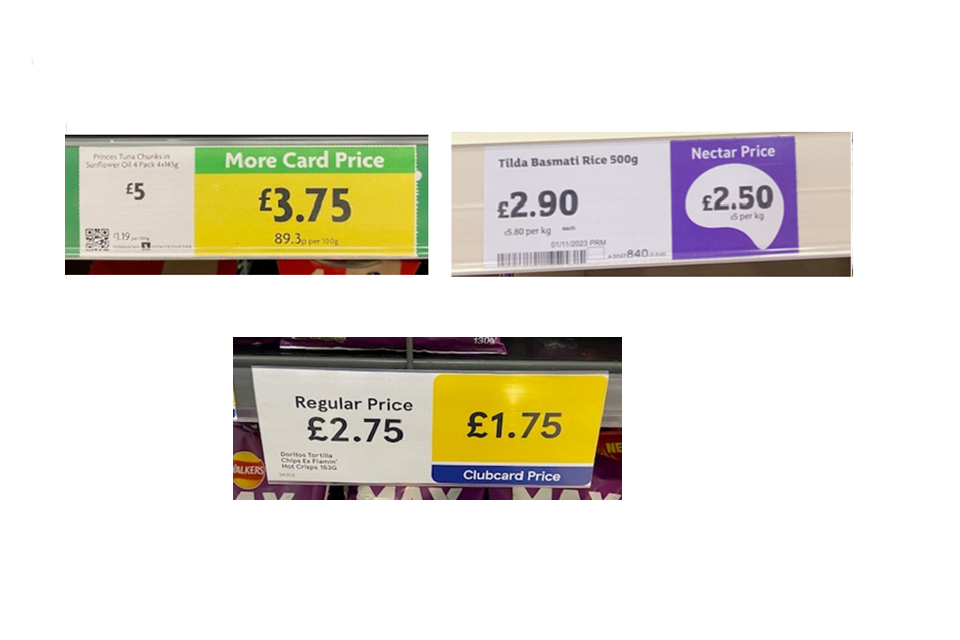Groceries: Loyalty prices offer genuine savings, says CMA
The CMA looked at thousands of products to see if loyalty prices offered genuine savings – the evidence says yes.

CMA review of 50,000 loyalty priced products shows 92% offered genuine savings against the usual price – despite 55% of people thinking ‘usual’ prices are upped to make loyalty deals more appealing.
The Competition and Markets Authority (CMA) has found that people who are members of a loyalty scheme can almost always make a genuine saving on the usual price by buying loyalty priced products.
Having analysed around 50,000 grocery products on a loyalty price promotion, the CMA found very little evidence of supermarkets inflating their ‘usual’ prices to make loyalty promotions seem like a better deal.
George Lusty, Interim Executive Director of Consumer Protection, said:
We know many people don’t trust loyalty card prices, which is why we did a deep dive to get to the bottom of whether supermarkets were treating shoppers fairly. After analysing tens of thousands of products, we found that almost all the loyalty prices reviewed offered genuine savings against the usual price – a fact we hope reassures shoppers throughout the UK.
While these discounts are legitimate, our review has shown that loyalty prices aren’t always the cheapest option, so shopping around is still key. By checking a few shops, you can continue to stretch your hard-earned cash.
Key findings
As part of the CMA’s work to help people facing cost of living pressures, it conducted a rigorous investigation of loyalty pricing. This sought to get to the bottom of a number of potential concerns, including whether loyalty prices can be trusted, how they compare to prices at other supermarkets and how accessible they are.
The CMA conducted a consumer survey to understand what shoppers specifically think about loyalty pricing, for example: do they trust it, do they think it’s fair, and does it change where people choose to shop. The CMA also examined supermarkets’ behaviour – including, importantly, their use of customers’ data.
The evidence shows that:
-
almost all products scrutinised – 92% of around 50,000 items – offered a genuine saving against the ‘usual’ price in the same store
-
while loyalty prices are generally some of the cheapest available, this wasn’t always the case meaning it’s worth shopping around
-
people can make an average saving of 17-25% buying loyalty priced products at the 5 supermarkets examined: Tesco, Sainsbury’s, Waitrose, Co-op and Morrisons
-
76% of shoppers say loyalty pricing has not changed where they shop, but 24% now compare prices more due to the introduction of loyalty pricing
-
55% of those surveyed think the price for non-members is inflated during loyalty price promotions
-
43% of those surveyed think it is unfair that loyalty scheme members pay lower prices for some products than those without a membership
-
people’s concerns about how their personal data is used is not stopping them from joining a loyalty scheme – only 7% of those surveyed said they hadn’t signed up to a scheme due to personal data concerns
-
some supermarkets could do more to make sure that certain shoppers – such as those without smart phones and the elderly – are able to join and make use of loyalty schemes
As part of its wide-ranging review, the CMA also looked at the way supermarkets collect and use people’s data when they sign up to a loyalty scheme. It did not see evidence of consumer law concerns in relation to this.
However, the CMA did find that there was room for improvement regarding people’s ability to access loyalty schemes. Some supermarkets could do more to ensure people without smart phones or under 18s, for example, can access – and know how to access – loyalty prices. This could include introducing offline sign-up, in-store or via the telephone for example, and lowering the minimum age for joining a scheme.
Figure 1: Examples of how supermarkets display loyalty prices in stores

Notes to editors
-
Loyalty pricing (also called ‘member pricing’ and ‘dual pricing’) is a type of promotion where a retailer makes a product available at two prices simultaneously – a cheaper price for shoppers who are members of their loyalty scheme, and a higher price for those who are not members.
-
To test whether prices and savings were genuine, the CMA analysed the loyalty prices of the 5 supermarkets offering loyalty price promotions at the start of its review: Tesco, Sainsbury’s, Waitrose, Co-op and Morrisons (Lidl has started to offer loyalty pricing more recently). We assessed over 50,000 products that were on a loyalty price promotion in August and November 2023 to check whether the savings were genuine by looking at the price charged in the weeks before, during and after the loyalty price promotion.
-
For its comparative price analysis, the CMA looked at 429 branded products on a loyalty promotion at one, or more, of Tesco, Sainsbury’s, Morrisons and Co-op. It then collected price data for up to 6 other supermarkets (Asda, Co-op, Morrisons, Ocado, Sainsburys, Tesco and Waitrose) if they also sold the identical branded products, to compare the prices. Discounters Aldi and Lidl were not included in this analysis as neither supermarket sells online and neither offers a wide enough range of branded products to enable a like-for-like price comparison.
-
While Iceland, Marks & Spencer, Ocado and Asda have loyalty schemes, they do not offer loyalty pricing.
-
The CMA found that the information provided to consumers is likely to give shoppers a good understanding of what is being done with their data. For example, the supermarkets reviewed outline the types of personal data they collect, such as purchase history and preferences, and explain how this data is used.
-
All media enquiries should be directed to the CMA press office by email on press@cma.gov.uk, or by phone on 020 3738 6460.